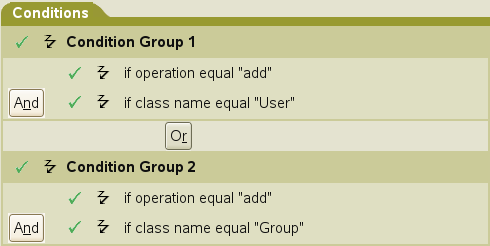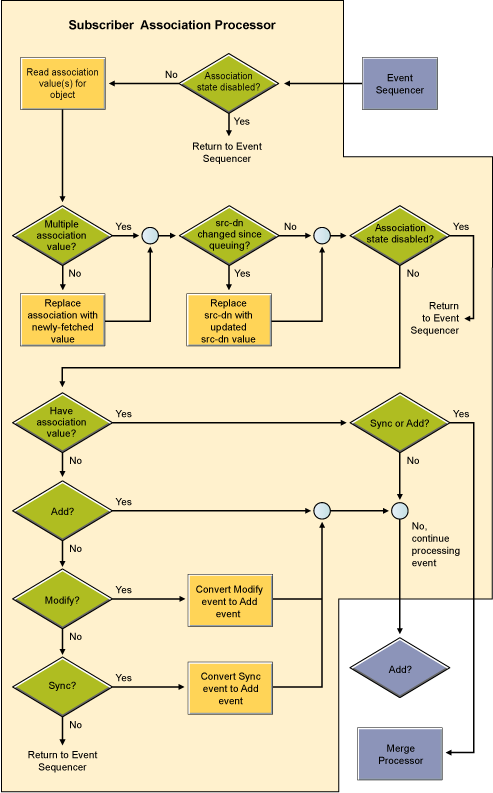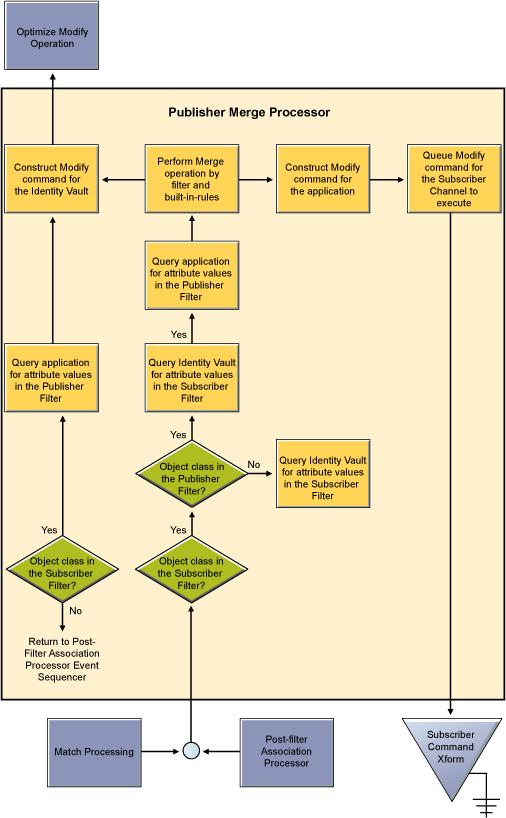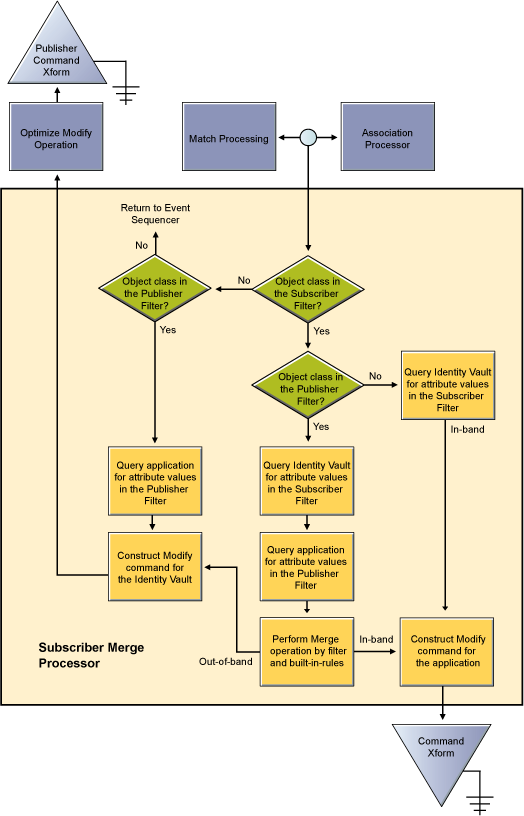6.13 Rules, Policies, and Style Sheets
Within any one of the rules covered above (Input Transform, Command Transform, etc.) are zero or more policies. Some of these may come from the preconfigured driver import used as a starting point. Others could be customizations of the driver configuration.
A rule in Identity Manager is a collection of policies. Each rule has conditions that have to be met, and actions to be carried out when the conditions are true. The grammar of the conditions is meant to be human readable and generally to make sense. For example, a condition of “if object class equal user” would be True if the object being described in the current document is a User object, and would be False if the object is a Group. Conditions are made up of Condition Groups. Within a Condition Group, all of the conditions can be combined with And or Or, and the result must be True for the Condition Group to evaluate to True, otherwise it evaluates to False. Multiple Condition Groups can also be combined, using And and Or. Once the Condition Group(s) have evaluated to True, the Rule's Actions are performed.
Figure 6-2 Policy Builder Conditions

Actions can act on the current document, and in many cases this is sufficient. But Actions can also query the source or destination, which could be Identity Vault or the connected system, depending on which channel you are on, for additional information. Actions can change the current document in to a modified version of itself, or can block it entirely. Actions can be used to make different documents. A document describing a delete event in a connected system could be tested by a Condition (if operation equal delete), and acted on by a set of Actions to prevent the associated object from being deleted in Identity Vault (veto), but to modify that object to remove its association value for this application (remove-association), and to disable it (set destination attribute value Login Disabled = True).
Figure 6-3 Policy Builder Actions

Policies define what data is transferred and how the data is synchronized between the connected system and the Identity Vault. A default set of policies is available with the driver configuration. Other policies might be local customizations of the driver. You can write policies using the DirXML Script, XSLT, or ECMA Script.
The purpose of a policy is to make changes to the input document and produce an output document. Most policies are evaluated either on the Subscriber channel or on the Publisher channel. The Schema Mapping policy, the Input Transformation policy, and the Output Transformation policy are evaluated on both channels. For example, one organization might use the inetOrgPerson as the main user class, while another organization might use User. A policy can be implemented to add the phone number change to an inetOrgPerson for the first organization, and a separate rule can be implemented to make it work for the User class. Policies make schema transformations, specify matching criteria to determine if an object already exists in the connected system or the Identity Vault, and many other things. Because of this, an Add event reported by your connected system might end out as a Modify operation in the Identity Vault, if a matching policy determines that the object you added already exists in the Identity Vault.
On the Subscription channel, when a new user is created in the Identity Vault and you want it created in the connected system, before sending this command to the driver, the Identity Manager engine calls a series of policies. These policies define the way objects are created and determine if a corresponding user already exists in the connected system, make decisions about placement, provide default values for required attributes that are not specified, and so on. This Add event might be transformed into a Modify event if the object exists in the connected system. Attributes that were not contained in the original event could be added to conform with the object creation model of the connected system.
Style sheets define XSLT transformation rules. Style sheets transform input or output commands into a different command, change an event from one type to another, or perform other arbitrary XML transformations. For more information, see Identity Manager Style Sheets.
6.13.1 Input Transform Rule
The Input Transformation rule applies to both the Subscriber channel and to the Publisher channel. The purpose of the Input Transformation rule is to perform a preliminary transformation on all XML documents sent to Identity Manager by the connected system and returned to Identity Manager from the connected system. The Input Transformation rule is applied to the XML documents sent to XmlCommandProcessor.execute and XmlQueryProcessor.query when called by the connected system and to the XML documents returned from SubscriptionShim.execute and XmlQueryProcessor.query when called by Identity Manager engine. The Input Transformation policy is applied before the Schema Mapping policy.
The Input Transform rule is often used to transform data from the application format into the Identity Vault format. When the Input Transformation is used for data format transformations the Output Transformation policy usually performs the data transformation in the opposite direction (transforms data from the Identity Vault format to the connected system format). This rule operates in the connected system’s (application's) namespace. For example, it might be used to reformat data, such as changing a phone number that is formatted as 1(815)555-1212 to 1-815-555-1212. The Input Transformation rule is also used to perform actions in response to the results of commands sent to the shim. Note that the schema names are always in the application namespace in the XML processed by the Input Transformation policy. It is also possible to use the Input Transformation rule to transform an arbitrary XML format native to the connected application to the format expected by Identity Manager. Such transformations must be written in XSLT because DirXML-Script operates only on the Identity Manager specific XML vocabulary that is specific to Identity Manager. A few examples are the Delimited Text driver and the SOAP driver.
6.13.2 Output Transform Rule
The Output Transformation policy applies to both the Subscriber channel and to the Publisher channel. The purpose of the Output Transformation policy is to perform a final transformation on all XML documents sent to the shim by the Identity Manager engine and returned to the shim by Identity Manager engine. The Output Transformation policy is applied to the XML documents sent to SubscriptionShim.execute and XmlQueryProcessor.query when called by the Identity Manager engine and to the XML documents returned from XmlCommandProcessor.execute and XmlQueryProcessor.query when called by the shim. The Output Transformation rule is applied after the Schema Mapping rule.
The Output Transform rule is the converse of the Input Transform rule. It modifies the command that is about to be submitted to the shim as required. This usually involves undoing what has been done in the Input Transform rule. If you have an Input Transform rule that converts phone numbers formatted as 1(815)555-1212 to 1-815-555-1212, you need to have an Output Transform rule that converts 1-815-555-1212 to 1(815)555-1212.
You can also use the Output Transformation policy to transform the format used by Identity Manager to an arbitrary XML format native to the connected application. These transformations must be written in XSLT because DirXML-Script operates only on the XML vocabulary that is specific to Identity Manager.
6.13.3 Associations
The Association value is Identity Manager’s way of keeping track of which object in the connected system matches an object in the Identity Vault. Each driver handles this slightly differently. In almost all cases, this should be a 1:1 match, so that it is possible to say that “john doe”, employee number 1234567 in the HR system matches exactly with the user object “jdoe13” in the Identity Vault, with “doe john” in Active Directory, and jdoe13@example.com” in the e-mail system. Most connected systems have some sort of internal unique identifier, even if it is not the one that you usually see in the system's management tools. eDirectory and Active Directory have a globally unique identifier or GUID. Many HR systems have an employee number. E-mail systems usually have a unique email address value for each person. Identity Manager uses these identifiers to build its association. Associations are stored in the Identity Vault only. On the Subscriber channel, the Identity Manager engine uses this value to allow the shim to modify the correct object in the connected system. On the Publisher channel, the shim supplies the association value, allowing the Identity Manager engine to quickly and easily find the correct object in the Identity Vault to work with. The following association states are stored in the Identity Vault:
-
0 Disabled: Changes in the driver objects are not synchronized with the Identity Vault.
-
1 Processed: Successful association has been created between the driver objects and Identity Vault.
-
2 Pending: The Identity Manager engine identified a modification to an object, and attempted to match it or create it in the connected system, but was unable to do so.
-
3-Manual: A manual association was created by the user.
-
4-Migrate: The account was synchronized or migrated.
-
blank No association: No association has been created.
6.13.4 Synthetic Adds
When a Modify document without an association encounters the Add Processor, the Identity Manager engine converts the Modify event into a Synthetic Add process. This process happens on the Publisher or the Subscriber channel.The Identity Manager engine uses the Modify event to figure out which object to work with. It then uses the filter to query back to get all attributes that are available for that object that are set to Sync or Notify on the current channel. It then throws away the Modify document and builds an Add document to replace it. This Add document is then forwarded through the Matching, Create, Placement, and Command Transformation (on the Subscriber it also goes through the Schema Map and Output Transformation).
Figure 6-4 Subscriber Channel Association Processor

6.13.5 Merge Processing
A Merge operation occurs when the Identity Manager engine converts an Add operation into a Modify operation. This happens most commonly during an initial migration, as the migration sends objects down a channel, and the Matching rule finds an object that it can use to associate with the object being migrated.
In a Merge operation, the current document is discarded again (like the Synthetic Add), and the filter is used to query both the connected system and the Identity Vault for all values. The setting for each attribute in the filter is used to decide what to do with the data. The options include overwriting the source information with the information from the destination, overwriting the destination with the source, combining the two and updating both with the results, or doing nothing. The following flow charts illustrate the Publisher Merge Processor and the Subscriber Merge Processor.
Figure 6-5 Publisher Merge Processor

Figure 6-6 Subscriber Merge Processor
